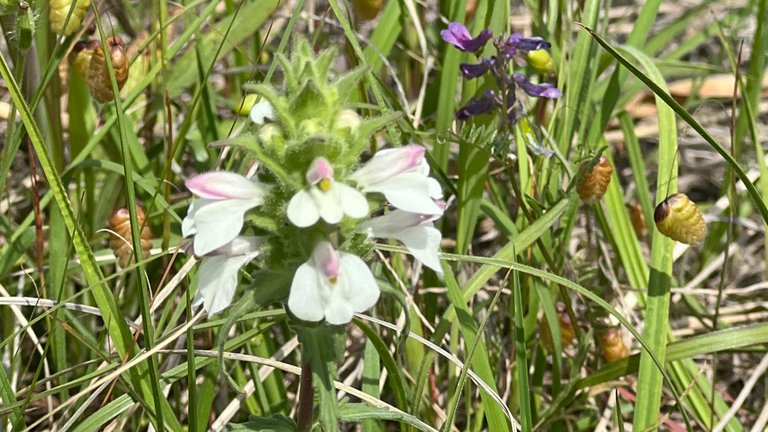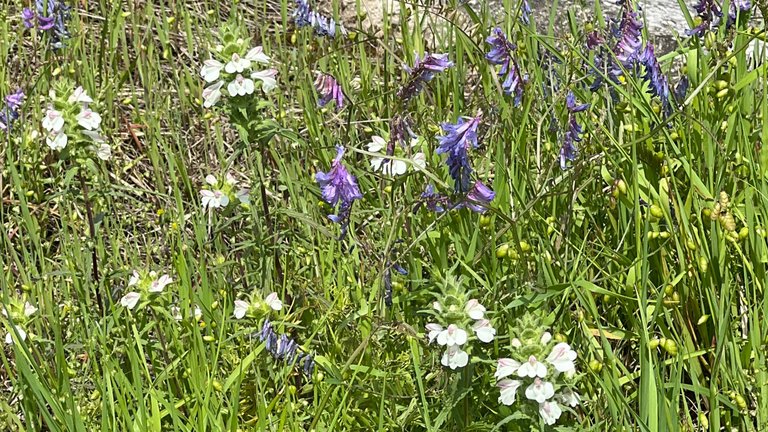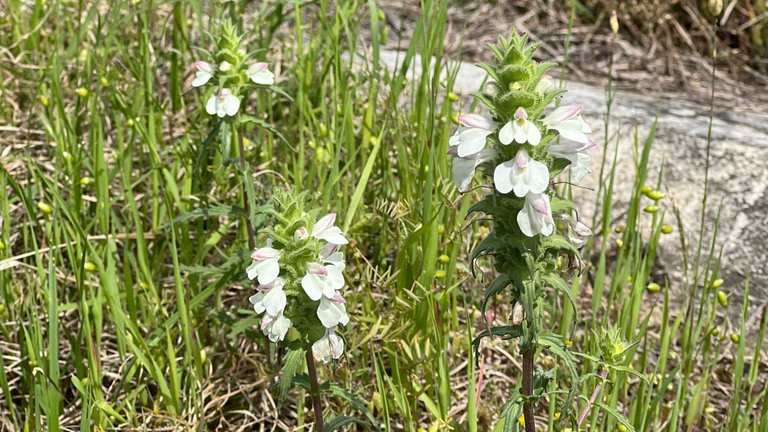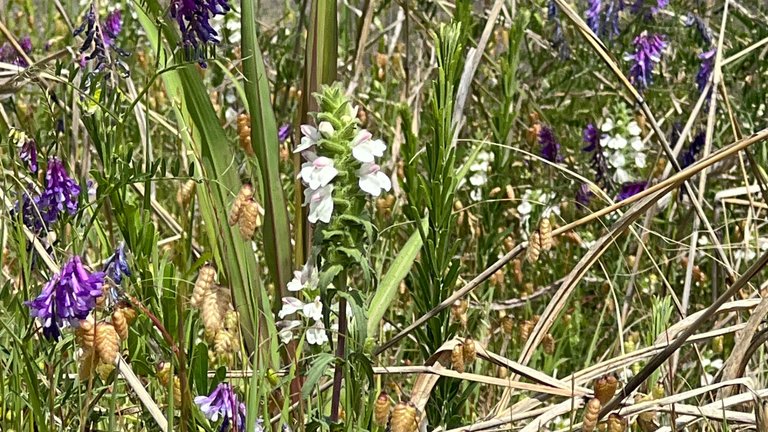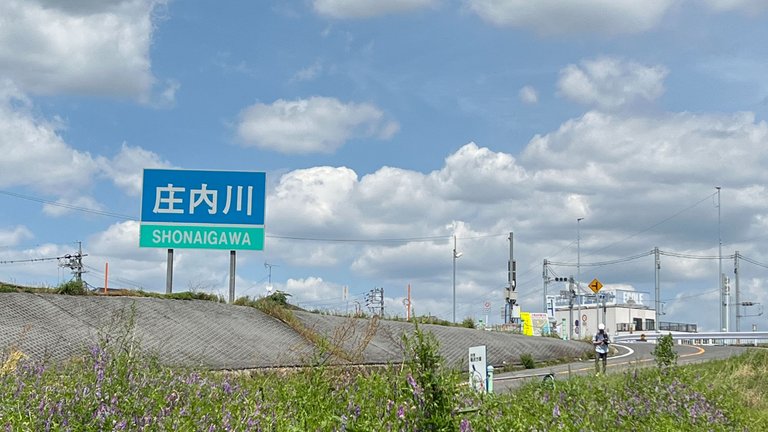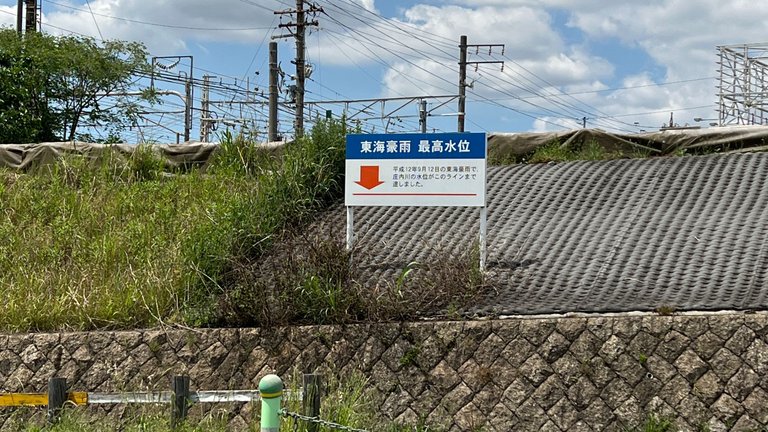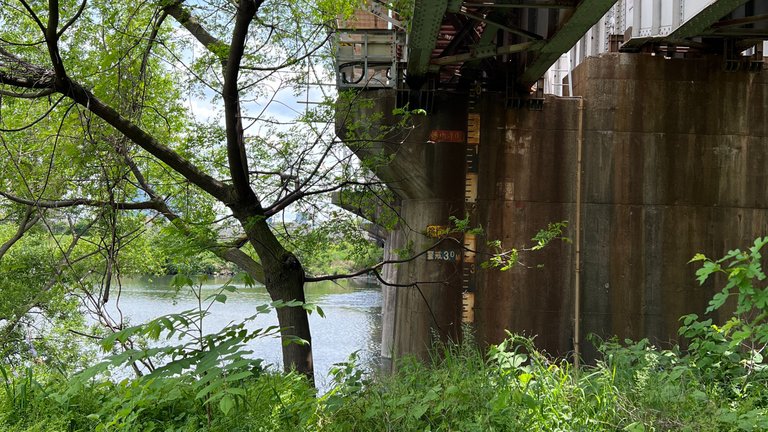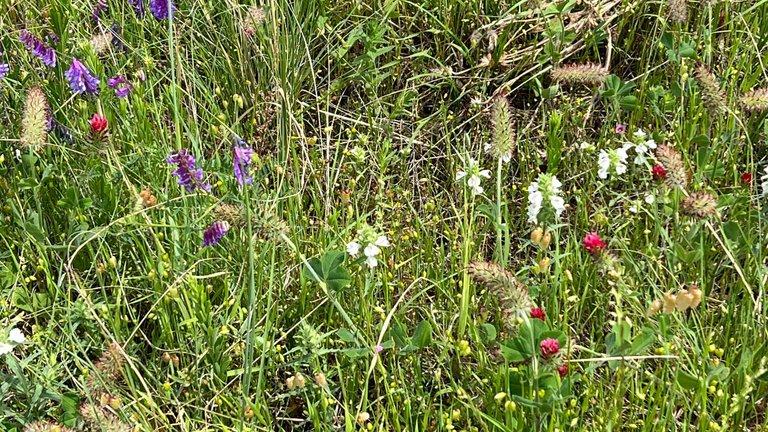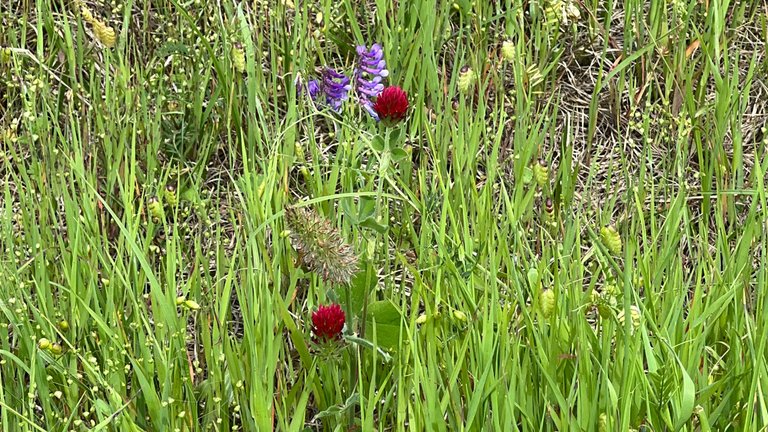The article in Japanese is in the second half.★日本語の記事は後半に。
As I began to walk along the embankment along the river I could see many wildflowers growing thick and blooming.
Among them were many conspicuous white flowers.
This flower is called "Hisauchi sou.
Like the "nayokusa fuji," this is also an exotic plant. It is said to be native to the Mediterranean region.
The name "Hisauchi sou" comes from Mr. Hisauchi, a naturalized plant researcher who studied exotic species.
The area I saw had only the most common white flowers.
After returning home, I did my own research and found that there is a yellow flower that looks very similar to this Hisauchi sou, which is another non-native plant species.
In this way, they only look like beautiful spring flowers to me.
Nayokusa fuji and Hisauchi sou are blooming side by side in the green area on the embankment.
But I have often heard that many non-native plant species have multiplied, and are now threatening to destroy the native species of Japan.
In today's world, where logistics is very active with imports and exports, there are many cases of plant seeds being carried in.
There are also very many cases of insects being transported.
I am sure that many measures are needed to strictly prevent these.
As I was walking along the river, I saw several places where stones were placed on the riverbed like this.
This is a very simple type of bench.
There is no table, but you can sit here and take a rest.
I guess the wildflowers are dead during the winter, but already in May, they are covered with grass up to here.
When you walk along the embankment, you will sometimes see a warning sign.
It reads as follows: 1.
- the levees are basically maintained for "river maintenance
- they are usually open to the public for walking, jogging, and cycling.
- however, the environment is not always pleasantly maintained.
Yes, it means that the grass is not always neatly mowed and rest areas are not always available.
Still, many people walk, jog, and cycle, so the paths are certainly made where people and bicycles can walk and cycle without problems.
Nayokusa fuji and Hisauchi sou were also in bloom near this simple bench.
I couldn't help but take many pictures. Flowers are beautiful.
Standing on the embankment, look at the opposite side of the river. This is the one where the city is spread out.
There is a sign with the name of the river and a sign that leaves how far the river level has risen during the last flood.
The red arrow shown on the sign and the location of the red line below it do not say exactly how many meters it is.
However, the water level at this location was so high that regular cars were completely submerged in the water up to their roofs.
I am told that the water level was such that even trucks could not move, so I think it was about 3 meters.
It is hard to imagine immediately that water rushes in from the river to a height far above one's head.
However, when this area was flooded, it took three whole days for the water to recede.
The land is low in the area where the river extends, and even though the plain is easy to live in on a daily basis, it is necessary to be prepared for disasters.
Since this is a very large river, there are a number of bridges along the way.
The two photos here show the piers of the bridge where the train tracks pass and the piers of the bridge where the public road passes, mainly for cars, as seen from the embankment walkway.
Both have water level scales written on them, indicating at what height a "caution" or "warning" will be issued.
Some of the scales have been around for a long time, while others have been newly installed recently.
As I continued walking, a red flower appeared.
I looked this up after returning home and learned that it was also a plant called "safflower clover.
It blooms around May, and since summer is very hot in Japan, this plant, which is vulnerable to heat, withers away.
This is also a legume, a member of the clover family introduced from Europe as a useful plant that takes up nitrogen in the soil, and is said to give tractors less trouble because of its soft plant body.
It is also said that if it can be successfully grown until summer, it has the power to keep pests living in the soil at bay, making it useful for agriculture, and is favored by farmers who want to use as little pesticide as possible in their farming.
It looks so pretty that seedlings are also sold as ornamental flowers under the name of "strawberry candle," and I may have seen some seedlings at a home improvement store without knowing it.
This kind of blooming on the banks can be seen all over Japan.
The colorful flowers bloom strongly and the fresh greenery is beautiful. This kind of scenery strikes a chord in both photographs and paintings.
It is an ordinary landscape of thick wildflowers, but it is full of vitality.
We will walk along the river again for a while.
To be continued in the next issue.

■diary with a few words
Japan's spring holiday and Golden Week is over today.
It has been raining since this afternoon, but most of the days were sunny and it was a nice holiday weekend.
I was also happy to be able to do some meaningful walking.

Japanese★ここから日本語でお送りいたします。
川に沿って堤防を歩き始めると、私はたくさんの野草が茂って花が咲いているのを見ることができました。
その中でも目立つ白い花がたくさん咲いていました。
この花は「ヒサウチソウ(Hisauchi sou)」と言います。
こちらも「ナヨクサフジ」と同じく、外来の植物です。地中海沿岸が原産地なのだそうです。
「ヒサウチソウ(Hisauchi sou)」の名前の由来は、外来種の研究をしていた帰化植物研究家の久内氏から名付けられたのだそうです。
私が見たエリアには、最も一般的な白い花だけがありました。
帰宅してから自分で調べたところ、このヒサウチソウにとてもよく似た黄色い花があるそうで、それはまた別の外来種の植物なんだそうです。
こうしてみると、私には春の美しい花々に見えるのみです。
ナヨクサフジとヒサウチソウが並んで、堤防の緑地に咲いています。
けれど多くの外来種の植物が繁殖し、日本固有種を駆逐する勢いになっているという話はよく聞きます。
輸出入で物流がとても活発な現代では、植物の種が運ばれてくることは多くあります。
虫が運ばれてくる事例もとても多いです。
これらを厳重に防ぐには多くの対策が必要なんだろうな、と思います。
私が川に沿って歩いていると、このように河川敷に石が置いてあるのを何箇所か見かけました。
これはとても簡易型ですがベンチです。
テーブルがないですが、ここに腰掛けて休憩をすることができます。
冬の間は野草が枯れているのだと思いますが、もう5月になるとここまで草に埋もれています。
堤防を歩いていると時々注意書きがあります。
それを読むとこう書かれています。
- 堤防は、基本的に「河川の整備」のために整備されています。
- 通常は市民に開放されていてウォーキング、ジョギング、サイクリングができます。
- ただし、常に快適に環境が整えられているわけではありません。
そう、常に綺麗に草刈りされて、休憩場所を利用できるわけではないということです。
それでも多くの人がウォーキング、ジョギング、サイクリングしているので、人や自転車が通る場所は確実に道ができていて、問題なく歩けるようになっています。
この簡易型ベンチの側にもナヨクサフジとヒサウチソウが咲いていました。
思わず何度も写真に撮ってしまう景色です。花は美しいです。
堤防に立って、川と反対側を眺めてみます。街が広がっている方です。
川の名前の看板と、前回の水害の時にどこまで川の水位が上昇してきたかを残した看板があります。
看板に示された赤い矢印とその下にある赤いラインの位置は、正確に何メートルかは書かれていません。
しかし、この場所は普通車が屋根まで完全に水に沈んでしまうほどの水位になりました。
トラックも動けなくなる水位だったと聞いているので、3mくらいはあったと思います。
自分の頭を遥かに超える高さまで水が川から押し寄せてくるなんて、すぐには想像できません。
しかし、ここが水害にあった時は水が引くまで丸3日間かかりました。
川が広がる地域は土地が低く、平野は日常的には暮らしやすくても災害時の備えが必要です。
この川はとても大きな川なので、途中にいくつもの橋がかかっています。
ここにある2つの写真は、電車の線路が通っている橋の橋脚と、主に車のための一般道が通っている橋の橋脚を堤防の遊歩道から見たものです。
いずれにも水位の目盛りが書き込まれていて、どの高さまできたら「注意報が発令される」のか「警戒警報」が発令されるのかが表示されています。
昔からあるものもあれば、最近新しく取り付けられた目盛りもあります。
歩き続けると赤い花が現れました。
これも帰宅してから調べましたが「ベニバナツメクサ」という植物だそうです。
5月頃に開花し、日本では夏が非常に暑いので、暑さに弱いこの植物は枯れてしまうのだそうです。
これもまたマメ科植物で、土の中に窒素を取り込んでくれる有用な植物としてヨーロッパから導入されたクローバーの仲間で、植物体が柔らかいので、トラクターに与えるトラブルも少ないらしいです。
また、うまく夏まで育てることができたら、土の中に住む害虫を寄せ付けない力を持っているらしく、農業に有用だそうで、なるべく農薬を使わない農業をしたい農家さんには好まれているという話もあります。
見た目が可愛らしいので、観賞用の花として「ストロベリーキャンドル」という名前で苗も売られているそうで、私ももしかしたら知らない間にホームセンターで苗を見かけているかもしれません。
このように土手で咲いている様子は日本全国で見られるようになっています。
カラフルな花が力強く咲き、新緑も美しい。このような景色は写真でも絵画でも胸を打ちます。
何気ない野草の茂る風景ですが、生命力にあふれています。
またしばらく川を見ながら歩きます。
次回へ続きます。

■ひとこと日記
日本の春の連休・ゴールデンウィークも今日で終わりです。
今日の午後から雨天になっていますが、ほとんどの日が晴れて、良い連休だったと思います。
私も有意義なウォーキングができて、幸せでした。
Google Translate & DeepL, thank you as always.
I am glad that you read it :-)
今日も読んでくださってありがとうございます😊
